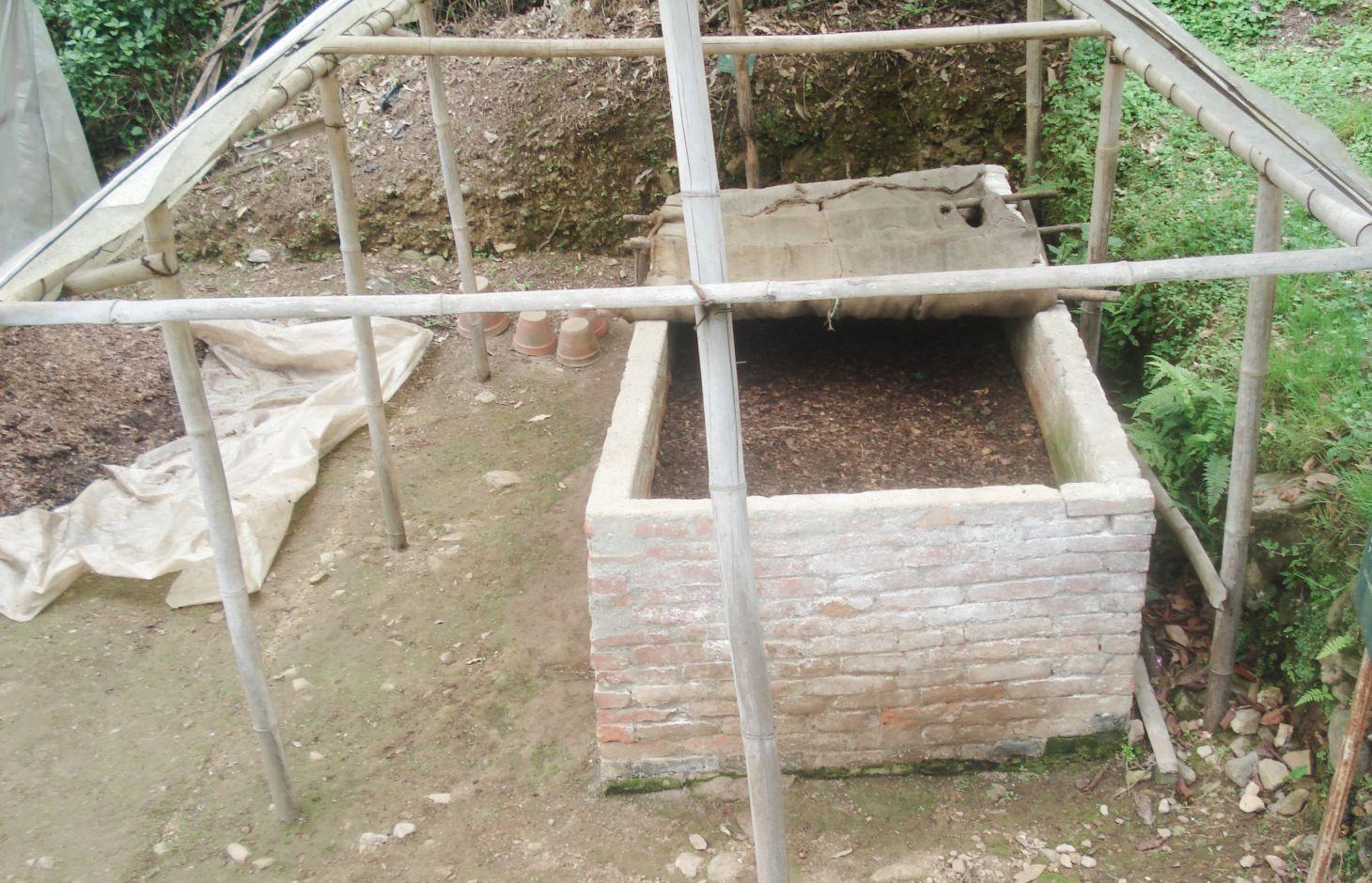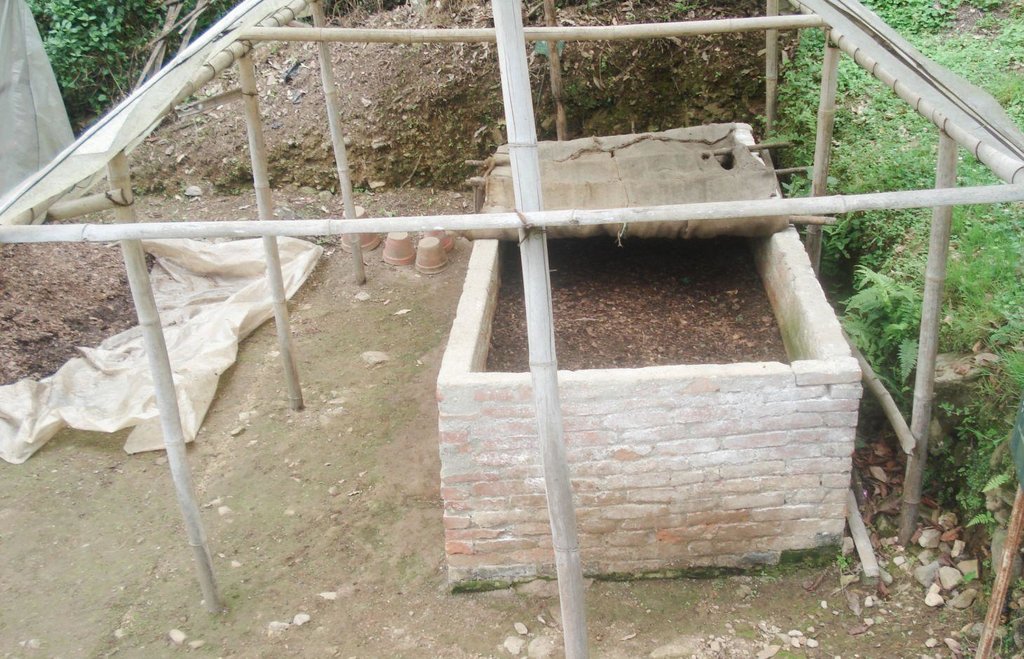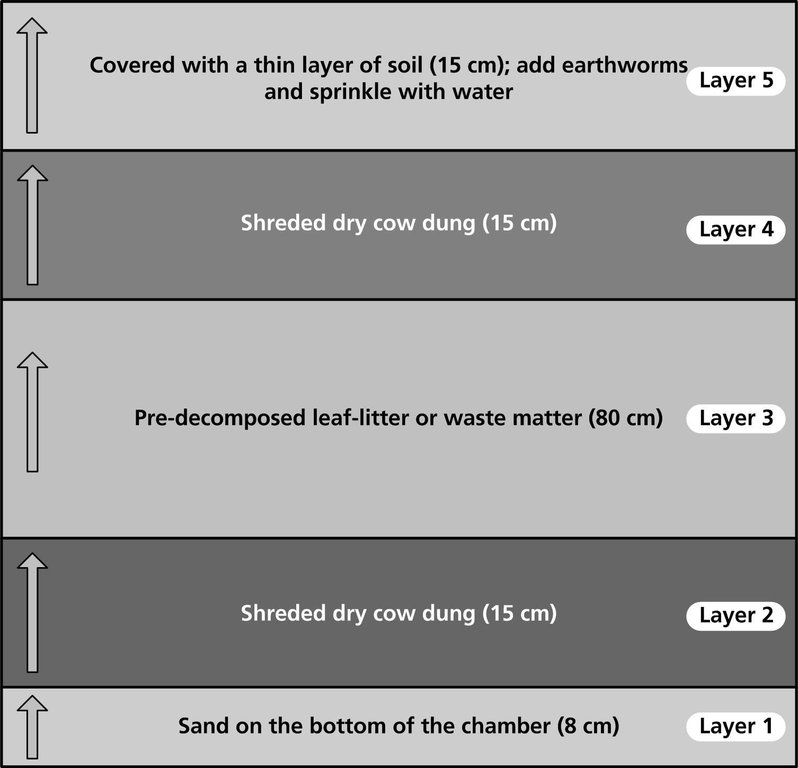Vermicomposting [Nepal]
- Creation:
- Update:
- Compiler: Shreedip Sigdel
- Editor: –
- Reviewers: David Streiff, Alexandra Gavilano
Gadaula proyog gari mal banaune prabidhi (Main Contributor: Samden Sherpa, ICIMOD)
technologies_1695 - Nepal
View sections
Expand all Collapse all1. General information
1.2 Contact details of resource persons and institutions involved in the assessment and documentation of the Technology
SLM specialist:
Sherpa Samden Lama
ICIMOD
Nepal
Name of the institution(s) which facilitated the documentation/ evaluation of the Technology (if relevant)
ICIMOD International Centre for Integrated Mountain Development (ICIMOD) - Nepal1.3 Conditions regarding the use of data documented through WOCAT
The compiler and key resource person(s) accept the conditions regarding the use of data documented through WOCAT:
Ja
2. Description of the SLM Technology
2.1 Short description of the Technology
Definition of the Technology:
Vermicomposting or worm composting is a simple technology for converting biodegradable waste into organic manure with the help of earthworms.
2.2 Detailed description of the Technology
Description:
Earthworms are valued by farmers because, in addition to aerating the soil, they digest organic matter and produce castings that are a valuable source of humus. Vermicomposting, or worm composting is a simple technology that takes advantage of this to convert biodegradable waste into organic manure with the help of earthworms (the red worm Eisenia foetida) with no pile turning, no smell, and fast production of compost. The earthworms are bred in a mix of cow dung, soil, and agricultural residues or predecomposed leaf-litter. The whole mass is converted into casts or vermicompost, which can be used as a fertilizer on all types of plants in vegetable beds, landscaping areas, or lawns.
Purpose of the Technology: Worms are so effective at processing organic waste that they can digest almost half their own weight in debris every day. Vermicomposting is a simple composting process that takes advantage of what earthworms do naturally, but confines the worms to bins making it easier for farmers to feed them and to harvest their nutrient-rich compost. Since all worms digest organic matter, in principle, any type of worm can be used; however, not all are equally well adapted to living in bins since some worms prefer to live deep in the soil while others are better adapted to living closer to the surface. The red worm (Eisenia foetida) is ideal for vermicomposting because its natural habitat is close to the surface and it is accustomed to a diet rich in organic matter, this makes it ideally suited to digesting kitchen scraps and to living in bins.
Establishment / maintenance activities and inputs: Vermicomposting can be carried out in different types of containers. There are only a few requirements for a good worm pit, the most important being good ventilation; the pit needs to have more surface area than depth (wide and shallow) and it needs to have relatively low sides. The base of the worm pit is prepared with a layer of sand then alternating layers of shredded dry cow dung and degradable dry biomass and soil are added. Under ideal conditions, 1,000 earthworms can covert 45 kg of wet biomass per week into about 25 kg of vermicompost.
Natural / human environment: Worm castings contain five times more nitrogen, seven times more phosphorous, and eleven times more potassium than ordinary soil, the main minerals needed for plant growth. The vermicompost is so rich in nutrients that it should be mixed 1:4 with soil for plants to be grown in pots and containers. Vermicompost should not be allowed to dry out before using.
Note: This type of vermicomposting is sometimes referred to as 'Pusa' vermicomposting because it was popularized in South Asia by the Rajendra Agricultural University located in Pusa, Bihar, India.
2.3 Photos of the Technology
2.5 Country/ region/ locations where the Technology has been applied and which are covered by this assessment
Country:
Nepal
Further specification of location:
Godavari, Lalitpur District
Specify the spread of the Technology:
- applied at specific points/ concentrated on a small area
2.7 Introduction of the Technology
Specify how the Technology was introduced:
- during experiments/ research
- through projects/ external interventions
3. Classification of the SLM Technology
3.1 Main purpose(s) of the Technology
- Improve fertilizer
3.2 Current land use type(s) where the Technology is applied

Cropland
- Annual cropping
- Perennial (non-woody) cropping

Forest/ woodlands
Products and services:
- Fuelwood
- Grazing/ browsing
Comments:
Major land use problems (compiler’s opinion): Crop productivity is limited by poor soil fertility, intense cropping, and a scarcity of irrigation water. Farmers notice a marked decrease in the health of their crops and degraded soil conditions when chemical fertilizers are overused. Vermicomposting is a low input response to this problem.
Forest products and services: fuelwood
Other forest products and services: fodder
3.5 SLM group to which the Technology belongs
- integrated soil fertility management
- waste management/ waste water management
3.6 SLM measures comprising the Technology

agronomic measures
- A2: Organic matter/ soil fertility
3.7 Main types of land degradation addressed by the Technology

chemical soil deterioration
- Cn: fertility decline and reduced organic matter content (not caused by erosion)
Comments:
Main causes of degradation: soil management
3.8 Prevention, reduction, or restoration of land degradation
Specify the goal of the Technology with regard to land degradation:
- prevent land degradation
4. Technical specifications, implementation activities, inputs, and costs
4.1 Technical drawing of the Technology
Technical specifications (related to technical drawing):
Establishing a vermicompost pit
Diagram showing the layers needed to set up a vermicompost pit. Note that the middle layer is the thickest; the worms start here and eat both upwards and downwards. It is best to house the pit under a thatched or plastic roof in order to shield it from excessive sunshine and rain.
Technical knowledge required for field staff / advisors: moderate
Technical knowledge required for land users: moderate
Main technical functions: increase in nutrient availability (supply, recycling,…), Improve Soil Fertility
Secondary technical functions: improvement of topsoil structure (compaction), Stabilizes that soil
Author:
AK Thaku
4.2 General information regarding the calculation of inputs and costs
Specify how costs and inputs were calculated:
- per Technology unit
Specify unit:
worm pit
Specify dimensions of unit (if relevant):
A typical outdoor pit can measure 4 m long, 1 m wide and 0.75 m high
Specify currency used for cost calculations:
- USD
4.3 Establishment activities
| Activity | Timing (season) | |
|---|---|---|
| 1. | A low cost pit can be constructed with bricks on a moist or shaded site | |
| 2. | If bricks are not available, stones can be used for the pit construction; | |
| 3. | alternatively, a wooden or bamboo box or a plastic tray can also be used. | |
| 4. | Vermicompost pits are best started during the summer months. | |
| 5. | A thatched roof was built over the pit to help retain moisture in the heap | |
| 6. | at a level of approximately 40–50%, as well as to maintain an optimal temperature of about 20–30oC. | |
| 7. | Sand, soil, cow dung, and leaf litter are piled up as shown in the diagram. | |
| 8. | Material Used are Bricks and cement, dry cow dung, plastic sheet/bamboo, earthworm (around 2000) |
4.4 Costs and inputs needed for establishment
| Specify input | Unit | Quantity | Costs per Unit | Total costs per input | % of costs borne by land users | |
|---|---|---|---|---|---|---|
| Labour | Construction of pit | persons/day/unit | 10.0 | 5.0 | 50.0 | |
| Construction material | Brick and cement | unit | 1.0 | 70.0 | 70.0 | |
| Construction material | Dry cow dung | unit | 1.0 | 10.0 | 10.0 | |
| Construction material | Plastic sheet/bamboo | unit | 1.0 | 70.0 | 70.0 | |
| Construction material | Earthworm (2000) | unit | 1.0 | 60.0 | 60.0 | |
| Total costs for establishment of the Technology | 260.0 | |||||
| Total costs for establishment of the Technology in USD | 260.0 | |||||
Comments:
Duration of establishment phase: 3 month(s)
4.5 Maintenance/ recurrent activities
| Activity | Timing/ frequency | |
|---|---|---|
| 1. | Water regularly and collect, harvest vermicompost | |
| 2. | The pit is watered regularly. After five to six weeks, the top layer is removed and piled in one corner of the pit. After a few days, the worms will have borrowed down to the bottom of this pile and the compost can be harvested. The compost prepared in the pit should be harvested within 6 months and the pit refurbished as for the first set as discussed above. |
4.6 Costs and inputs needed for maintenance/ recurrent activities (per year)
| Specify input | Unit | Quantity | Costs per Unit | Total costs per input | % of costs borne by land users | |
|---|---|---|---|---|---|---|
| Labour | Watering pit | persons/day/unit | 5.0 | 5.0 | 25.0 | |
| Construction material | Dry cow dung | unit | 1.0 | 5.0 | 5.0 | |
| Construction material | Water pipe | unit | 1.0 | 10.0 | 10.0 | |
| Total costs for maintenance of the Technology | 40.0 | |||||
| Total costs for maintenance of the Technology in USD | 40.0 | |||||
4.7 Most important factors affecting the costs
Describe the most determinate factors affecting the costs:
All costs and amounts are rough estimates by the technicians and authors. This was a demonstration project conducted by ICIMOD.
5. Natural and human environment
5.1 Climate
Annual rainfall
- < 250 mm
- 251-500 mm
- 501-750 mm
- 751-1,000 mm
- 1,001-1,500 mm
- 1,501-2,000 mm
- 2,001-3,000 mm
- 3,001-4,000 mm
- > 4,000 mm
Agro-climatic zone
- sub-humid
Thermal climate class: temperate
5.2 Topography
Slopes on average:
- flat (0-2%)
- gentle (3-5%)
- moderate (6-10%)
- rolling (11-15%)
- hilly (16-30%)
- steep (31-60%)
- very steep (>60%)
Landforms:
- plateau/plains
- ridges
- mountain slopes
- hill slopes
- footslopes
- valley floors
Altitudinal zone:
- 0-100 m a.s.l.
- 101-500 m a.s.l.
- 501-1,000 m a.s.l.
- 1,001-1,500 m a.s.l.
- 1,501-2,000 m a.s.l.
- 2,001-2,500 m a.s.l.
- 2,501-3,000 m a.s.l.
- 3,001-4,000 m a.s.l.
- > 4,000 m a.s.l.
5.3 Soils
Soil depth on average:
- very shallow (0-20 cm)
- shallow (21-50 cm)
- moderately deep (51-80 cm)
- deep (81-120 cm)
- very deep (> 120 cm)
Soil texture (topsoil):
- medium (loamy, silty)
Topsoil organic matter:
- high (>3%)
If available, attach full soil description or specify the available information, e.g. soil type, soil PH/ acidity, Cation Exchange Capacity, nitrogen, salinity etc.
Soil fertility is medium
Soil drainage / infiltration is medium
Soil water storage capacity is medium
5.4 Water availability and quality
Ground water table:
< 5 m
Availability of surface water:
good
Water quality (untreated):
good drinking water
Comments and further specifications on water quality and quantity:
Water quality (untreated): Also for agricultural use (irrigation)
5.5 Biodiversity
Species diversity:
- high
Comments and further specifications on biodiversity:
695 species of flora and 230 species of fauna have been documented within the Park's 30 ha area
5.6 Characteristics of land users applying the Technology
Market orientation of production system:
- mixed (subsistence/ commercial)
Off-farm income:
- > 50% of all income
Relative level of wealth:
- poor
Level of mechanization:
- manual work
- animal traction
Indicate other relevant characteristics of the land users:
Population density: < 10 persons/km2
5.7 Average area of land used by land users applying the Technology
- < 0.5 ha
- 0.5-1 ha
- 1-2 ha
- 2-5 ha
- 5-15 ha
- 15-50 ha
- 50-100 ha
- 100-500 ha
- 500-1,000 ha
- 1,000-10,000 ha
- > 10,000 ha
5.8 Land ownership, land use rights, and water use rights
- Governement
- ICIMOD
- ICIMOD
5.9 Access to services and infrastructure
roads and transport:
- poor
- moderate
- good
labour:
- poor
- moderate
- good
6. Impacts and concluding statements
6.1 On-site impacts the Technology has shown
Socio-economic impacts
Income and costs
expenses on agricultural inputs
workload
Comments/ specify:
The vermicompost pit needs to be watered and maintained regularly
Other socio-economic impacts
Earthworms need to be purchased from outside
Socio-cultural impacts
livelihood and human well-being
Comments/ specify:
Provides employment opportunities. Quality compost helps to improve the soil and increases crop production
Ecological impacts
Other ecological impacts
soil fertility
can be used to produce organic crops
use of chemical fertilizer
6.2 Off-site impacts the Technology has shown
dependency on external inputs
6.3 Exposure and sensitivity of the Technology to gradual climate change and climate-related extremes/ disasters (as perceived by land users)
Other climate-related consequences
Other climate-related consequences
| How does the Technology cope with it? | |
|---|---|
| active in warm climate | well |
6.4 Cost-benefit analysis
How do the benefits compare with the establishment costs (from land users’ perspective)?
Short-term returns:
positive
Long-term returns:
positive
How do the benefits compare with the maintenance/ recurrent costs (from land users' perspective)?
Short-term returns:
positive
Long-term returns:
positive
6.5 Adoption of the Technology
Comments:
There is a strong trend towards spontaneous adoption of the Technology
Comments on adoption trend: Vermicomposting training was provided to farmers in Nuwakot, Rasuwa, Godavari, and Bishankhunarayan VDCs by ICIMOD staff in collaboration with local NGOs. More than 60% of the farmers who received training adopted vermicomposting on their own farms and they have also started selling worms to other farmers. The technology has been adopted by others who have visited the ICIMOD Knowledge Park at Godavari but most of these are just interested in introducing it on a small scale, such as, to produce vermicompost from kitchen waste for household use in their own gardens. The participants were also taught how to collect local earthworms to use for composting.
Drivers of adaptation of the technology
• A simple technology and easy to implement
• Local earthworms can be used.
• Not expensive; farmers can construct pits or uses wooden boxes or plastic trays.
• Produces high quality compost with a high concentration of nutrients
• Helps to reduce pests in the soil
• Can be scaled up to produce compost commercially
6.7 Strengths/ advantages/ opportunities of the Technology
| Strengths/ advantages/ opportunities in the compiler’s or other key resource person’s view |
|---|
|
The use of vermicompost reduces the need for chemical fertilizers and reduces dependence on outside sources. How can they be sustained / enhanced? Promote the technology by disseminating it to a large number of farmers on both small and big farms |
|
Vermicomposting does not require keeping livestock. How can they be sustained / enhanced? It is considered to be a low-cost alternative that uses local earthworms and materials to produce compost. |
| On-farm composting saves the transportation cost needed to deliver compost to the farm. |
6.8 Weaknesses/ disadvantages/ risks of the Technology and ways of overcoming them
| Weaknesses/ disadvantages/ risks in the compiler’s or other key resource person’s view | How can they be overcome? |
|---|---|
| Purchasing earthworms from outside may be expensive for farmers. | Farmers can be encouraged to harvest local earthworms for composting. |
| Making compost from earthworms is not very popular in rural areas. | Create greater awareness on how earthworms can be used to compost leaf-litter and other kitchen waste. |
7. References and links
7.1 Methods/ sources of information
7.3 Links to relevant online information
Title/ description:
Vermicomposting: Journey to forever organic garden (no date)
URL:
http://journeytoforever.org/compost_worm.html
Links and modules
Expand all Collapse allLinks
No links
Modules
No modules





